人教版Unit13教案
人教版英语九年级全册Unit13setionA(3a3c)教学设计
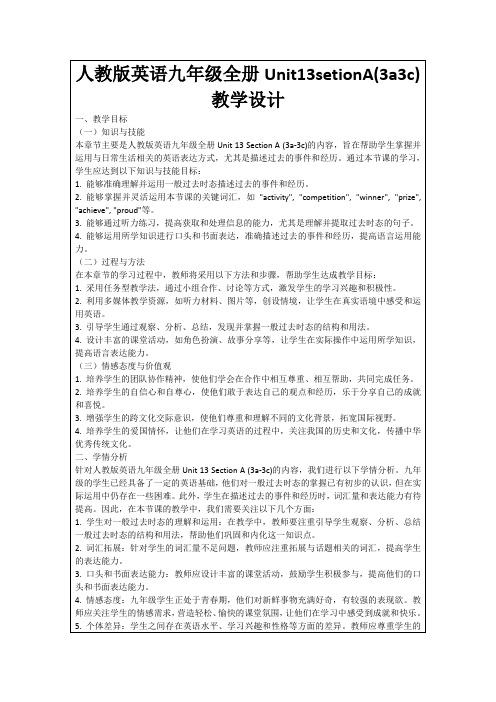
(三)学生小组讨论
1.教学活动设计:教师将学生分成小组,每组选择一个话题,如“last weekend”(上周末)、“my favorite sports activity”(我最喜欢的体育活动)等,要求小组成员用一般过去时态讨论并分享自己的经历。
人教版英语九年级全册Unit13setionA(3a3c)教学设计
一、教学目标
(一)知识与技能
本章节主要是人教版英语九年级全册Unit 13 Section A (3a-3c)的内容,旨在帮助学生掌握并运用与日常生活相关的英语表达方式,尤其是描述过去的事件和经历。通过本节课的学习,学生应达到以下知识与技能目标:
3.引导学生通过观察、分析、总结,发现并掌握一般过去时态的结构和用法。
4.设计丰富的课堂活动,如角色扮演、故事分享等,让学生在实际操作中运用所学知识,提高语言表达能力。
(三)情感态度与价值观
1.培养学生的团队协作精神,使他们学会在合作中相互尊重、相互帮助,共同完成任务。
2.培养学生的自信心和自尊心,使他们敢于表达自己的观点和经历,乐于分享自己的成就和喜悦。
4.能够运用所学知识进行口头和书面表达,准确描述过去的事件和经历,提高语言运用能力。
(二)过程与方法
在本章节的学习过程中,教师将采用以下方法和步骤,帮助学生达成教学目标:
1.采用任务型教学法,通过小组合作、讨论等方式,激发学生的学习兴趣和积极性。
2.利用多媒体教学资源,如听力材料、图片等,创设情境,让学生在真实语境中感受和运用英语。
6.课后作业:
-布置与课堂内容相关的作业,如完成一篇日记,描述过去一天的经历,要求使用一般学生进一步巩固和提高。
英语人教版九年级全册Unit13Savethesharks!教学设计

Unit 13 We We’’re trying to save the earth!Section A (3a-3b) Save the sharks!一、教学目标:1. 语言知识目标基本词汇:shark, fin, cruel. harmful, chain, ecosystem, industry, law, scientific, 基本词组:be harmful to, at the top(of sth.), throw away基本句型:No scientific studies have showed that shark fins are good for health.We should help save the sharks. 2. 情感目标: be friendly to nature, call for people be friendly to nature, call for people not’ Finning’not’ Finning’not’ Finning’ any more. any more.3. 能力目标:use reading skill (skimming ,scanning ,careful reading )to get the main idea.二、教学重难点:How to catch the main idea of the passage and how to call for people to protect the endangered animals.三、教学用具:多媒体,纸四、教学方法:Skimming, Scanning, careful reading五、教学步骤:Step one: Warming upPlay a guessing game, let students guess the animals.通过猜谜游戏调动课堂气氛,引出鲨鱼的话题。
人教版九年级英语Unit 13 We're trying to save the earth! 全单元教案

Unit 13We're trying to save the earth!本单元围绕环境保护的话题,并用主题图片表现噪音污染、空气污染、水污染等内容,目的是为了让学生对环境的破坏有一个直观的认识,从而激发学生强烈的社会责任感和对未来发展的思考。
Section A的重点是让学生掌握与环境污染和环境保护相关的词汇和句型,同时引导学生关爱动物、保护环境。
教学难点是让学生学会正确使用连词和结合生活实际讲述如何保护环境。
Section B在Section A所学的基础上,进一步谈论如何保护环境。
教学重点是让学生了解环境保护的方式,并落实到积极的行动当中,同时还有阅读策略和写作技巧的训练。
教学难点是让学生在阅读2a文章之后,根据所给词根找出衍生出的不同词汇,并理解前缀和后缀的不同用法。
The First Period—Section A(1a-2d)Teaching Important Points【教学重点】Key words & phrases:litter,bottom,fisherman,coal,ugly,advantage,cost,wooden,plasticnoise pollution,air pollution,water pollution,be full of,play a part in,turn…into,cut down air pollutionKey sentences:1.Even the bottom of the river was full of rubbish.2.It used to be so clean.3.Everyone in this town should play a part in cleaning it up.4.The air is badly polluted because there are more cars on the road these days.5.The air has become really polluted around here.6.We're trying to save the earth.Key structure:should+do;used to+do;have/has+done;be+done;be+doinge.g.Everyone should help to clean up the river.The air has become really polluted.I used to be able to see stars in the sky.The air is badly polluted.Teaching Difficult Points【教学难点】★Practice the structures to talk about pollution and environmental protection.Teaching Aids【教学工具】A tape recorder,CAI or multimedia courseware.Teaching Steps【教学过程】★Step 1Leading in【新课导入】1.Greeting2.Discussion and reviewDiscuss with the students,like this:T:What kinds of pollution are there these days?S:…T:What causes the pollution?S:…3.Review the words and expressions about the topic.★Step 2Cooperative inquiry【合作探究】1.Finish the task in 1a①Show pictures or play videos about pollution and talk about the pollution.②Read these phrases in 1a.Look at the pictures in 1a and say what they see in the pictures.Write down the words and add more words.③Ask students to say out their words in each kind of pollution.2.Finish the task in 1b①Read the instructions.Get the students to read the contents in the chart and think of what they will fill in the blanks.②Play the recording for the first time.Students listen and fill in the words.③Play the recording a second time.Ask them to check the answers.Then ask the questions.Students answer with full sentences.④Ask more questions to help students learn more details.Then play the recording for the students to role-pay the conversation.3.Finish the task in 1c①Show the key words of the conversation.Ask students to retell the contents in the chart.Like this:What:dirty;bottom,rubbish;fishWhy:littering,putting wasteHow:write to,close down;help to clean up②Read aloud the model dialogue in 1c.Then in pairs,do the oral practice with more words.③Ask two pairs to perform in class.4.Finish the tasks in 2a-2b①Use PPT or pictures to show the four kinds of pollution.Get the groups of students to havea competition to say words about the pollution one by one.land pollution:…air pollution:…noise pollution:…water pollution:…②Get the students to write down these words in their notebooks.③Play the recording for the first time.Students listen and circle the kinds of pollution.Check answers with the class.④Read the sentences in 2b.Predict the contents they will fill in.Play the recording.Students listen and complete the sentences.⑤Play the recording again.Check the answers with the whole class.5.Finish the task in 2c①Read the sample conversation in 2c.Then Read the listening materials and discuss in pairs what causes the two kinds of pollution.②Students work in pairs,making dialogues.③Ask three pairs to role-play their conversations to the class.6.Finish the task in 2d①Talk about the picture in 2d.Ask:What are your ideas for solving the air pollution/waste pollution problem?Present the new words in the conversation.Such as,coal,advantage,wooden,plastic,takeaway,bin,…②Read the conversation in 2d quickly.Find out the problems about environmental pollution in the dialogue.③Read the conversation again.Ask the students to find the ways to solve the problems of air and waste pollution.④Read aloud the conversation by the recording.⑤Learn the useful expressions:What are your ideas for doing…To cut down air pollution,we should…So together,our actions can make a difference and…⑥Role-play or read the conversation in pairs until fluently.★Step 3Homework1.What are your ideas for solving the waste pollution problem?2.Write the words about the four kinds of pollution.3.Translate the following sentences into English.(1)我们正在想办法拯救地球。
人教版英语九年级全册Unit13Savethesharks!教学设计

(五)总结归纳
1.教学活动:教师引导学生对本节课的学习内容进行总结。
2.教学方法:采用反思性教学法,让学生自我总结、互相评价。
3.教学内容:回顾本节课所学的词汇、语法、句型以及讨论的问题,总结保护鲨鱼的重要性。
4.教学目标:帮助学生巩固所学知识,培养他们的反思能力,提高课堂教学效果。
(二)讲授新知
1.教学活动:教师引导学生学习本节课的核心词汇、短语及主要语法结构。
2.教学方法:采用讲解、示范、练习相结合的方式,帮助学生掌握新知识。
3.教学内容:
(1)词汇:endangered, extinction, illegal, hunting, eco-system, conservation, protection等;
(2)写作中:指导学生进行初稿、修改、互评等环节,提高写作质量;
(3)写作后:组织学生进行作品展示,培养他们的自信心和表达能力。
5.注重课堂评价,采用多元化评价方式,关注学生的个体差异,激发学生的学习动力。
6.结合信息技术,利用网络资源,拓展学生的学习视野,提高英语素养。
7.建立课后辅导机制,针对学习困难的学生,给予个性化指导,帮助他们克服学习难点。
(2)略读:快速阅读全文,了解文章大意;
(3)寻读:查找关键信息,完成相关任务;
(4)细读:深入理解文章细节,分析文章结构,学习语言表达;
(5)评价读:评价文章内容,发表自己的观点。
4.写作教学采用过程写作法,关注学生写作过程中的思维发展。
(1)写作前:引导学生进行头脑风暴,收集素材,明确写作主题;
三、教学重难点和教学设想
(一)教学重难点
1.重点:
人教版英语九年级全册Unit13SectionA(1a2d)教学设计

b.撰写阅读笔记,分享阅读感悟。
6.家庭作业:学生与家长共同讨论家庭规则,学会与父母沟通。
a.家长参与,了解学生的学习情况,增进亲子关系。
b.学生向家长请教家庭规则制定的原因,增进对父母的理解。
2.讲解一般现在时的用法,特别是第三人称单数形式的动词变化,让学生在句子中实际操作,加深印象。
3.引导学生学会使用情态动词can和must表达许可、要求和禁止,并通过实例进行比较,让学生明确两者的区别。
(三)学生小组讨论(500字)
1.教师提出讨论话题:“Should parents set rules for their teenagers? Why?”,引导学生分组进行讨论。
b.对于学习困难的学生,给予个别辅导,帮助他们克服难点。
c.对于学习优秀的学生,提供拓展性任务,提高他们的英语水平。
6.课后作业设计富有针对性,既巩固课堂所学,又培养学生的自主学习能力。
a.设计听、说、读、写四方面的作业,全面提高学生的英语能力。
b.鼓励学生进行课后阅读,拓宽知识面,提高人文素养。
c.布置小组合作任务,培养学生的团队合作意识和沟通能力。
3.通过角色扮演、讨论和辩论等形式,提高口语表达能力。
4.运用一般现在时,特别是第三人称单数形式的动词变化,进行句子练习。
5.运用情态动词can和must,表达许可、要求和禁止。
6.通过学习本节课的主要句型,学会在实际情境中运用。
(三)情感态度与价值观
在本章节的学习中,学生将培养以下情感态度与价值观:
1.尊重家庭规则,学会与父母沟通,表达自己的需求和想法。
2.理解父母的担忧和期望,学会换பைடு நூலகம்思考。
3.培养独立思考和解决问题的能力,为成为有责任感和自律能力的青少年奠定基础。
人教版九年级英语全一册Unit13单元整体教学设计

4.ห้องสมุดไป่ตู้The qualities and influence of celebrities.
此外,教师还应对学生的课堂表现进行评价,鼓励他们在课后继续关注名人的事迹,将所学知识运用到实际生活中。同时,提醒学生树立正确的价值观,努力学习,成为对社会有贡献的人。
(二)过程与方法
1.通过小组合作、讨论、分享等形式,激发学生的学习兴趣,培养合作精神。
2.利用多媒体教学资源,如:视频、图片、音频等,丰富课堂教学,提高学生的学习积极性。
3.引导学生运用阅读策略,提高阅读效率,培养良好的阅读习惯。
4.创设真实的语言环境,让学生在实际语境中运用所学知识,提高语言运用能力。
2. Translate sentences about the celebrity's achievements.
3. Write a short passage about a celebrity you admire.
4. Role-play a conversation about a famous person.
(二)讲授新知
本阶段,教师将结合教材内容,系统地讲解本章节的核心词汇、短语和语法。首先,学习与名人相关的词汇,如:fame, achievement, contribution等,通过例句、图片等形式让学生理解和记忆。接着,讲解一般现在时、一般过去时和现在完成时在描述名人成就时的运用,让学生掌握时态的用法。此外,通过阅读课文,分析文章结构,学习如何描述名人的生平和成就。
8.家校合作:与家长沟通,共同关注学生的学习进展,鼓励家长参与学生的英语学习,形成良好的学习氛围。
人教版九年级英语Unit 13 We’re trying to save the earth 教案
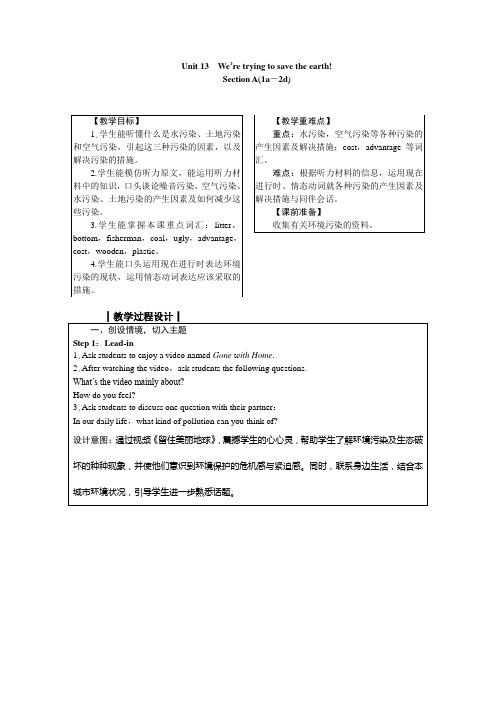
Unit 13We’re trying to save the earth!Section A(1a-2d)┃教学小结┃【板书设计】Unit 13We’re trying to save the earth!Section A(Section A(3a-4c)┃教学小结┃Section B(1a-1e)┃教学小结┃Section B(2a-2e)设计意图:读前预测,为学生在接下来的阅读中获取文章大意作准备。
思维导图可以帮助学生理清文章脉络。
Step 5:Use pictures to teach the new words.When students think about the questions in Step 3,the teacher can write down the new words on the blackboard.And teach them the new words.设计意图:适时呈现词汇,可以减轻学生的阅读压力。
While readingStep 6:Fast reading1.Ask students to look through the article quickly and find out the answer to each question.How many people are mentioned in the passage?Who are they?2.The teacher adds information to the mind-map.设计意图:扫读整篇文章,获取大意,帮助学生把握文章的整体性。
Step 7:Careful reading(Paragraph 2)1.Ask students to read Paragraph 2 carefully and fill in the chart.2.Check answers.3.The teacher adds the information to the mind-map.Step 8:Careful reading(Paragraph 3)1.Ask students to read Paragraph 3 carefully and fill in the chart.2.Check answers.Name What did she make?What materials did she use?Jessica Wong bags old clothes,especially old jeans3.The teacher adds the information to the mind-map.Step 9:Careful reading(Paragraph 4)1.Ask students to read Paragraph 4 carefully and fill in the chart.2.Check answers.Name What did he make?What materials did he use?Wang Tao beautiful art pieces iron and other materials from old cars3.The teacher adds the information to the mind-map.Which things can be done by common people every day?Which things have to be done by governments and organizations?Common people Governments Organizations2.Ask several groups to give a report.设计意图:教师让学生对所学的保护环境的措施进行归纳和分类,培养学生分析问题和解决问题的能力。
人教版九年级英语全册Unit13SectionAGrammarFocus优秀教学案例

3.分析现在完成时态与一般过去时态的区别,让学生明白现在完成时态强调过去对现在的影响。
4.设计一些练习题,让学生尝试运用现在完成时态,巩固所学知识。
(三)学生小组讨论
1.将学生分成若干小组,每组讨论以下问题:
3.教师对学生的学习情况进行全面评价,既要关注知识与技能的掌握,也要关注情感态度与价值观的培养。
4.根据学生的反思和评价,教师及时调整教学策略,以提高教学效果。
四、教学内容与过程
(一)导入新课
1.教学开始时,利用PPT展示一组反映学生生活、成长的图片,如参加生日派对、旅游、体育比赛等,引导学生观察并描述图片内容。
2.组织学生进行小组讨论,共同分析课本中的例句,总结现在完成时态的用法和特点。
3.鼓励学生提问,解答他们在学习过程中遇到的困惑,帮助他们深入理解现在完成时态。
(三)小组合作
小组合作是一种有效的教学策略,有助于提高学生的合作意识和团队精神。
1.将学生分成若干小组,让他们共同完成现在完成时态的填空、改错等练习,培养学生的合作能力。
5.注重实践与应用,提高语言能力
本案例注重让学生在实际语境中运用现在完成时态,通过丰富多样的教学活动,如角色扮演、故事创编等,让学生在实践中提高英语表达能力。这种注重实践与应用的教学方法,有助于提高学生的语言综合运用能力。
3.鼓励学生在日常交流中积极运用现在完成时态,提高英语表达能力。
(五)作业小结
1.课后作业:完成课本练习中与现在完成时态相关的习题,巩固所学知识。
2.拓展作业:让学生用现在完成时态写一篇短文,描述自己在学校的一天或一周的生活,注意运用本节课所学的时间状语。
人教版英语九年级全册Unit13We'retryingtosavetheearth!优秀教学案例

4.对小组合作进行评价,关注学生的参与度、贡献度和团队合作效果。
(四)反思与评价
1.引导学生进行自我反思,思考自己在学习过程中的优点和不足,培养自我评价和自我改进的能力。
2.组织学生进行同伴评价,鼓励他们互相提供反馈和建议,培养评价能力和批判性思维。
3.创设问题情境,让学生面临真实的环保问题,如水资源浪费、垃圾分类等,引导学生主动思考和寻找解决方案。
4.利用多媒体技术,如视频、音频、动画等,营造生动有趣的学习氛围,激发学生的学习兴趣和积极性。
(二)问题导向
1.设计有挑战性的问题,引导学生深入思考环保问题的本质和影响。
2.通过提问和讨论,引导学生自主探究和解决问题,培养他们的批判性思维和问题境的影响。
3.总结本节课的主要内容和知识点,确保学生对环保知识有一个全面而准确的理解。
(五)作业小结
1.布置相关的作业,如研究报告、行动计划等,让学生将所学知识运用到实际生活中去。
2.要求学生在作业中提出自己的观点和解决方案,培养他们的创新思维和批判性思维能力。
3.引导学生关注环保问题的多样性和复杂性,培养他们的分析和综合能力。
4.鼓励学生提出自己的问题,激发他们的好奇心和探索精神。
(三)小组合作
1.组织学生进行小组讨论和合作,鼓励他们分享自己的观点和想法,培养合作能力和团队精神。
2.设计小组活动,如共同完成一篇关于环保的文章、策划一次环保活动等,让学生实际行动起来,提高实践能力。
3.鼓励学生在作业中积极表达自己的想法,注重培养他们的写作能力和表达能力。
4.对学生的作业进行认真批改和评价,提供及时的反馈和建议,帮助学生巩固所学知识,提高他们的学习效果。
人教版九年级英语全册Unit13We’retryingtosavetheearth!教学设计
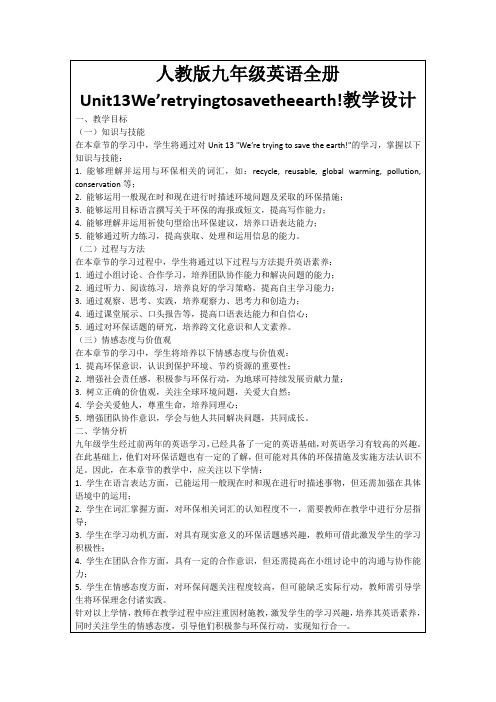
(3)海报制作:让学生分组制作环保海报,运用所学词汇和表达方式。
4.课后作业:
(1)要求学生撰写一篇关于环保的短文,巩固写作能力;
(2)鼓励学生参与环保活动,记录自己的行动和感受,提高实践能力。
5.评价与反馈:
(1)教师针对学生在课堂活动中的表现,给予及时、具体的评价;
-播放一段关于环保行动的听力材料,学生听后回答相关问题。
-教师引导学生总结听力材料中的关键信息,帮助学生提高获取、处理和运用信息的能力。
(三)学生小组讨论
1.教师将学生分成小组,每组选择一个环保主题,如:节约用水、减少塑料污染等。
2.小组内讨论以下问题:
- What are the main environmental problems related to your topic?
人教版九年级英语全册Unit13We’retryingtosavetheearth!教学设计
一、教学目标
(一)知识与技能
在本章节的学习中,学生将通过对Unit 13 "We’re trying to save the earth!"的学习,掌握以下知识与技能:
1.能够理解并运用与环保相关的词汇,如:recycle, reusable, global warming, pollution, conservation等;
1.完成课本练习册中与本课相关的练习题,特别是词汇填空、语法填空和听力练习,以加深对环保词汇和语法的掌握。
2.结合课堂所学,制作一份关于环保的海报,内容包括:环保主题、现状介绍、具体措施和建议。要求设计新颖,语言表达清晰,图文并茂。
3.撰写一篇短文,以“我的环保行动”为主题,描述自己在日常生活中实施的环保措施,以及对环保的认识和体会。字数在100-120词左右,要求使用一般现在时和现在进行时描述。
人教版英语九年级全一册教案:Unit13SectionA(3a-4c)

第 1 页 Unit13 SectionA (3a-4c ) 教案1.0 Teaching analysis 教情分析1.1 Teaching objectives 教学目标 1.1.1 Language goals 语言目标1.1.1.1 Key Words and Chunks1.1.1.1.1 For applying: cruel, harmful, be harmful to, at the top of, industry, law, scientific, take part in, afford, turn off, pay for, take action1.1.1.1.2 For comprehending: shark, fin, chain, the food chain, ecosystem, reusable, transportation1.1.1.2 Sentence Structures1) M any have heard of shark fin soup.2) B ut do you realize that you’re killing a whole shark ut do you realize that you’re killing a whole shark each time you enjoy a each time you enjoy abowl of shark fin soup?3) T his is not only cruel, but also harmful to the environment.4) S harks are at the top of harks are at the top of the food chain in the ocean’s ecosystem.the food chain in the ocean’s ecosystem.5) I f their numbers drop too low, it will bring danger to all ocean life.6) W ithout a fin, a shark can no longer swim and slowly dies.7) T he numbers of some kinds of sharks have fallen by over 90 percent in the last 20 to 30 years.8) T hey have even asked governments to develop laws to stop the sale ofshark fins. 9) S o far, no scientific studies have shown that shark fins are good for health,so why eat them?10) We We can’t can’t can’t afford to wait any longer to take action! afford to wait any longer to take action!1.1.1.3 Grammar Focus1) But do you realize that you’re killing a whole shark But do you realize that you’re killing a whole shark each time you enjoy a each time you enjoy abowl of shark fin soup? (each time 引导时间状语从句,意为“每当…”) 2) This is not only cruel, but also harmful to the environment. (notonly…but also…连接两个并列成分,意为“不仅…而且…”)3) So far, no scientific studies have shown that shark fins are good for health,so why eat them? (so far 意为“到目前为止”,是现在完成时的标志)4) Without a fin, a shark can no longer swim and slowly dies. (no longer 意为“不再”,等于not … any longer)1.1.2 Ability goals 能力目标1.1.2.1 To review the present perfect tense and the passive voice.1.1.2.2 To enable Ss to learn some of the key words and expressions in the reading passage.1.1.2.3 To cultivate Ss to read for specific ideas and the structure of the passage.1.1.3 Emotional goals 情感目标1.1.3.1 To help Ss understand the present situation of sharks.1.1.3.2 To raise Ss’ awareness of protecting animals. 1.2 Important and difficult teaching points 教学重难点1.2.1Enable Ss to learn and apply the sentence patterns. 1.2.2 Enable Ss to know the sharks are in danger.1.2.3 Guide Ss to help save the sharks.2.0 Student analysis 学情分析2.1 Fundamental State 基本情况通过本单元第一课时的学习,学生基本上激活了已有的语言知识,对本单元的话题(pollution and environmental protection )已经有所感知,对于environmental problems, how to solve air pollution, how to solve waste pollution 等内容有了更深入的学习。
新版人教版九年级英语Unit13全单元公开课教案共16页

新版人教版九年级英语Unit13全单元公开课教案共16页学科课型课题 English fresh 年级课时 9 1 / 6 班级媒体 a tape recorder, CAI Unit 13 we’re trying to save the earth!Section A 1a ~ 1c 话题Protecting the environment 功能 Talk about pollution and environmental protection 1. Target language: |m We’re trying to save the earth. People are throwing litter into the river. The river used to be so clean. Everyone should help to clean up the river. 2. Grammar: Present progressive, used to, modal verbs 3. Words and expressions; (1) Curriculum words: litter, bottom, fisherman (2) Useful expressions: be full of, put…into, throw…into, clean up, play a part in, close down According to designing some tasks, to train students’listening ability and to train students’ xxmunicative xxpetence.教学目标过程方法知识技能情感Everyone should keep our rivers clean. 态度学习策略Listening for key words, transforming information. 重点 Target Language 难点 1.How to train students’listening ability.2.How to train students’xxmunicative xxpetence.教学内容及问题情境学生活动设计意图 Look at the 1a. To introduce Ss to the unit goal, talk pictures and write these about pollution and environmental protection. words in the boxes below. Picture: Then write The four pictures show other words you know. different forms of environmental pollution. The first picture on the left shows an airplane flying 新|课 |标|第 |一| 网呈现本课重点词汇,认知,理解,记忆。
人教版英语九年级全册Unit13We’retryingtosavetheearth!大单元教学设计
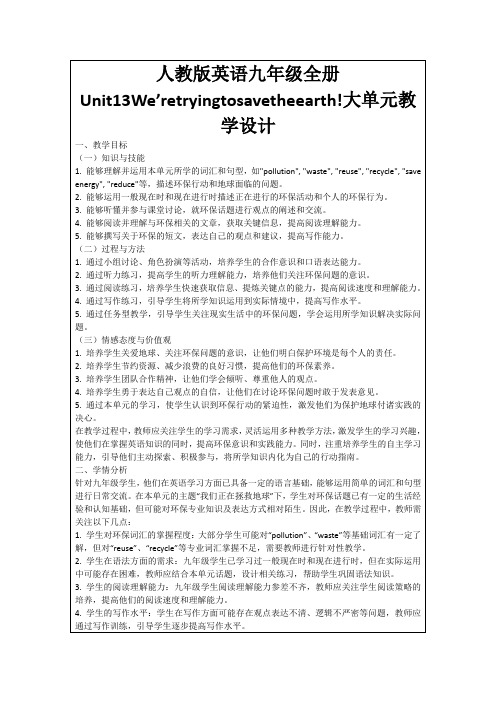
3.通过讨论,教师引入本单元的主题:“We’re trying to save the earth!”(我们正在尝试拯救地球),并简要介绍本节课的学习目标。
6.拓展延伸:鼓励学生在课后进行环保主题的研究,如调查身边的环保行为、采访环保人士等,将学习延伸到课堂之外。
四、教学内容与过程
(一)导入新课
在这一阶段,教师将采用多媒体资源和生活实例来导入新课,激发学生的学习兴趣和参与热情。
1.教师展示一系列关于地球环境问题的图片和视频,如森林砍伐、海洋污染、空气污染等,引导学生关注这些问题的严重性。
教学设想:通过词汇卡片、小组竞赛、情景剧等形式,让学生在实际语境中反复练习,加深记忆。
2.语法运用:现在进行时在描述正在进行的环保活动中的应用,以及一般现在时在陈述环保事实和习惯中的应用。
教学设想:设计语法练习,如填空、改错、句型转换等,帮助学生掌握语法规则,并通过真实的语境任务进行巩固。
3.阅读理解:提取文章主旨,理解作者观点,分析环保问题的原因和解决方案。
4.写作任务:请学生撰写一篇关于“我如何为地球环境保护做贡献”的短文,要求他们运用课堂所学的写作技巧,表达自己的观点和建议。
5.环保实践:鼓励学生在家中或学校进行一项环保实践活动,如回收废旧物品、节约用水用电等,并记录下来,在下一节课与同学分享。
6.家庭作业:布置一份综合性的家庭作业,结合本单元所学内容,要求学生观察并记录身边的环保行为,采访家人或朋友对环保的看法,整理成一篇小报告。
在教学过程中,教师应充分了解学生的学情,结合他们的需求和兴趣,设计有针对性的教学活动,激发学生的学习兴趣,提高他们的英语素养和环保意识。
人教版英语九年级全册Unit13Wearetryingtosavetheearth课教学设计
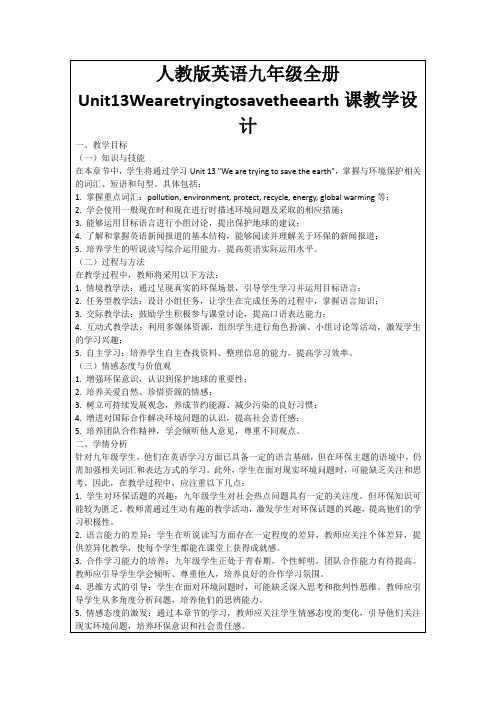
-通过问答、角色扮演等互动方式,巩固所学知识。
(三)学生小组讨论
1.教学活动设计:
-将学生分成小组,针对某一环境问题进行讨论,如空气污染、水污染等;
-小组成员分别扮演不同角色,如环保专家、政府官员、市民等,提出解决问题的建议;
-各小组汇报讨论成果,其他小组进行评价和补充。
-采用个别辅导和小组合作相结合的方式,关注学生的个体差异;
-及时反馈学生的练习情况,针对性地进行指导;
-鼓励学生积极参与,提高课堂练习的效果。
(五)总结归纳
1.教学活动设计:
-教师与学生一起回顾本节课所学的主要知识点;
-学生分享自己的学习心得和感悟;
-教师强调环保意识的重要性,并提出课后实践任务。
2.教学目标:
1.增强环保意识,认识到保护地球的重要性;
2.培养关爱自然、珍惜资源的情感;
3.树立可持续发展观念,养成节约能源、减少污染的良好习惯;
4.增进对国际合作解决环境问题的认识,提高社会责任感;
5.培养团队合作精神,学会倾听他人意见,尊重不同观点。
二、学情分析
针对九年级学生,他们在英语学习方面已具备一定的语言基础,但在环保主题的语境中,仍需加强相关词汇和表达方式的学习。此外,学生在面对现实环境问题时,可能缺乏关注和思考。因此,在教学过程中,应注重以下几点:
2.任务型教学法:设计小组任务,让学生在完成任务的过程中,掌握语言知识;
3.交际教学法:鼓励学生积极参与课堂讨论,提高口语表达能力;
4.互动式教学法:利用多媒体资源,组织学生进行角色扮演、小组讨论等活动,激发学生的学习兴趣;
5.自主学习:培养学生自主查找资料、整理信息的能力,提高学习效率。
人教版英语九年级全册Unit13We'retryingtosavetheearth单元优秀教学案例

3.问题导向教学,培养批判性思维
本案例采用问题导向的教学策略,引导学生围绕环保问题展开思考、讨论和分析。这种教学方式有助于培养学生的批判性思维,使他们学会独立思考问题,形成自己的观点。
-结合课本对话和文章,让学生在实际语境中学习语法。
3.通过听力练习,让学生熟悉与环保相关的新闻报道、故事和对话,提高他们的听力水平。
-播放听力材料,引导学生完成相关练习,并针对难点进行讲解。
(三)学生小组讨论
1.将学生分成小组,每组选择一个环保主题,如:气候变化、水资源保护等,进行资料收集和讨论。
-要求学生用英语记录关键信息,为后续的展示做准备。
1.设计反思性问题,如:“在本章节的学习中,你学到了哪些环保知识?”“你认为自己在环保方面有哪些改变?”等,引导学生进行自我反思。
2.组织学生进行同伴评价,让他们互相提出建议,共同进步。
3.教师对学生进行综合评价,关注学生在知识、技能、情感态度与价值观等方面的表现,鼓励他们持续进步。
四、教学内容与过程
人教版英语九年级全册Unit13We'retryingtosavetheearth单元优秀教学案例
一、案例背景
随着社会的快速发展,环境问题已经成为全球关注的焦点。在这样的背景下,人教版英语九年级全册Unit13"We're trying to save the earth"单元,以环境保护为主题,旨在培养学生对环境问题的关注和责任感。本案例将结合课本内容,通过多元化的教学活动,提高学生对环境保护的认识,激发他们积极参与环保行动的热情。在教学过程中,注重运用教育专业用词,以人性化的语言引导学生进行思考与讨论,使他们在掌握英语知识的同时,也能够关注到地球的可持续发展。
新版人教版九年级英语Unit13全单元公开课教案共16页

新版人教版九年级英语Unit13全单元公开课教案共16页ask them what they see。
Then。
ask them to predict what the article will be about based on the pictures.1b。
Play the recording and ask students to listen carefully for the target language and useful ns。
Have them take notes and then discuss their findings in pairs or small groups.1c。
Have students work in pairs or small groups to discussthe ns and prompts related to the article。
Encourage them to usethe target language and useful ns in their ns.The topic of this lesson is protecting the environment。
specifically focusing on n and environmental n。
The target language includes phrases such as "We're trying to save the earth" and "Everyone should help to clean up the river." The grammar covered includes present progressive。
used to。
and modal verbs。
nally。
students will learn new vocabulary words such as "litter," "bottom," and "fisherman."The teaching methods used in this lesson include listening for key words。
人教版九年级英语全册Unit13We’retryingtosavetheearth!优秀教学案例

3.学生能够理解课文内容,把握文章结构和主旨,提高他们的阅读理解能力。
4.学生能够通过模仿、角色扮演等方式,运用本课所学知识进行情景交际,提高他们的口语表达能力。
(二)过程与方法
1.学生通过自主学习、合作探讨等方式,分析课文内容,提高他们的自主学习能力和合作精神。
2.教师批改作业,了解学生的学习情况,对学生的进步给予肯定和鼓励,对需要改进的地方提出建议和指导。
3.学生根据教师的反馈,进行自我反思,调整学习方法,不断提高自己的学习效果。
五、案例亮点
1.情景创设:通过播放环保主题的视频和图片,让学生直观地感受到环境问题的严重性,激发他们的学习兴趣和环保意识。这种情景创设的方式不仅有助于吸引学生的注意力,而且能够使学生更加关注环保问题,从而提高他们的学习积极性和参与度。
2.问题导向:设计一系列与课文内容相关的问题,引导学生通过阅读、讨论等方式寻找答案,提高他们的阅读理解和思维能力。问题导向的教学策略有助于培养学生的批判性思维和问题解决能力,使他们在解决问题的过程中更好地理解和掌握知识。
3.小组合作:将学生分成小组,让他们共同完成环保主题的项目,如设计环保标语、制作环保宣传册等。小组合作的方式有助于培养学生的团队合作能力和创新精神,同时也能够提高他们的口语表达能力和交际技巧。
2.设计环保主题的场景,让学生参与其中,如模拟垃圾分类、能源节约等,让学生在实际操作中学习环保知识。
3.创设问题情境,让学生思考环保与生活的关系,如“你觉得我们应该如何减少塑料污染?”等,引导学生主动探索答案。
(二)问题导向
1.设计一系列与课文内容相关的问题,引导学生通过阅读、讨论等方式寻找答案,提高他们的阅读理解和思维能力。
人教版英语九年级Unit13《We’retryingtosavetheearth》全单元说课稿
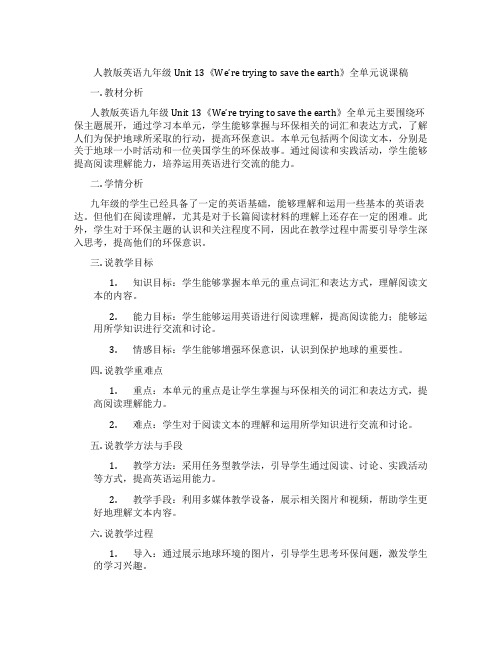
人教版英语九年级Unit 13《We’re trying to save the earth》全单元说课稿一. 教材分析人教版英语九年级Unit 13《We’re trying to save the earth》全单元主要围绕环保主题展开,通过学习本单元,学生能够掌握与环保相关的词汇和表达方式,了解人们为保护地球所采取的行动,提高环保意识。
本单元包括两个阅读文本,分别是关于地球一小时活动和一位美国学生的环保故事。
通过阅读和实践活动,学生能够提高阅读理解能力,培养运用英语进行交流的能力。
二. 学情分析九年级的学生已经具备了一定的英语基础,能够理解和运用一些基本的英语表达。
但他们在阅读理解,尤其是对于长篇阅读材料的理解上还存在一定的困难。
此外,学生对于环保主题的认识和关注程度不同,因此在教学过程中需要引导学生深入思考,提高他们的环保意识。
三. 说教学目标1.知识目标:学生能够掌握本单元的重点词汇和表达方式,理解阅读文本的内容。
2.能力目标:学生能够运用英语进行阅读理解,提高阅读能力;能够运用所学知识进行交流和讨论。
3.情感目标:学生能够增强环保意识,认识到保护地球的重要性。
四. 说教学重难点1.重点:本单元的重点是让学生掌握与环保相关的词汇和表达方式,提高阅读理解能力。
2.难点:学生对于阅读文本的理解和运用所学知识进行交流和讨论。
五. 说教学方法与手段1.教学方法:采用任务型教学法,引导学生通过阅读、讨论、实践活动等方式,提高英语运用能力。
2.教学手段:利用多媒体教学设备,展示相关图片和视频,帮助学生更好地理解文本内容。
六. 说教学过程1.导入:通过展示地球环境的图片,引导学生思考环保问题,激发学生的学习兴趣。
2.阅读理解:学生自主阅读文本,回答相关问题,教师进行讲解和指导。
3.小组讨论:学生分组讨论,分享各自的观点和感受,教师进行巡回指导。
4.实践活动:学生根据所学内容,进行角色扮演或写作练习,教师进行评价和指导。
- 1、下载文档前请自行甄别文档内容的完整性,平台不提供额外的编辑、内容补充、找答案等附加服务。
- 2、"仅部分预览"的文档,不可在线预览部分如存在完整性等问题,可反馈申请退款(可完整预览的文档不适用该条件!)。
- 3、如文档侵犯您的权益,请联系客服反馈,我们会尽快为您处理(人工客服工作时间:9:00-18:30)。
Unit 13:We’re trying to save the earth!一、教学目标:1. 语言知识目标基本词汇:litter, advantage, bottom, fisherman, coal, ugly, cost, wooden, plastic, takeaway, bin, shark, fin, method, cruel. Harmful, chain, ecosystem,industry, law, scientific, afford, reusable, transportation, recycle, napkin,upside, gate, bottle, president, inspiration, iron, work, metal, creativity, 基本词组:be harmful to, at the top(of sth.), take part in, turn off, take action, throw away, put sth. to good use, pull… down, bring back基本句型:We’re trying to save the earth!The river used to be so clean.The air is badly polluted.No scientific studies have showed that shark fins are good for health.We should help save the sharks.2. 技能目标: 能正确运用现在进行时,现在完成时,被动语态,情态动词和usedto 句型。
3. 情感目标:有环境危机意识,学会关注环境保护环境。
二、教学重难点:1. 教学重点:(1)能正确运用现在进行时,现在完成时,被动语态,情态动词和used to 句型。
(2)保护环境的措施方法。
2. 教学难点:能正确运用现在进行时,现在完成时,被动语态,情态动词和used to 句型。
三、教学步骤:Section A 1 (1a-1d)I. PresentationShow the picture of the earth and tell students the earth is polluted now.For example: (1) The factories that burn coal pollute the air with a lot of black smoke.(2) Factories put waste into the river.(3) People should throw away litter in the bin.(4)There are more cars on the road.II. LearningHere are some words related to different kinds of pollution. Write them in the box below. Then add more words.loud music cars rubbish planes littering ships factories smoking building houses mobile phonesnoise pollution air pollution water pollution____________ ___________ _________________________ ___________ _________________________ ___________ _________________________ ___________ _____________Keys: noise pollution loud music planes mobile phones building houses air pollution factories smoking cars building houseswater pollution ships rubbish littering factoriesIII. Listening1. 1b Listen and complete the sentences.What was the problem? The river was _____________. Even thebottom (底部) of the river was full of________. There were no more ______ forfishermen (渔民) to catch.What caused the problem? People are throwing _______ into the river.Factories are putting ______ into the river.How should the problem be solved? We should write to the ____________ and askthem to ___________ the factories. Everyoneshould help to __________ the river.Keys: really dirty rubbish fish litter waste governmentclose down clean up2. Listen again and check (√) the sentences you hear.1) We could go fishing in the river.2) The river was really dirty.3) The river has always been the nicest river in this town.4) We should ask the teachers for help.Keys: 2 3IV. Practice1. Role-play the conversation in 1c.Mark: The river was dirty. Even the bottom of the river was full of rubbish. Tony: But it used to be so clean!Mark: Yes, but people are throwing litter into the river.Tony: Everyone in this town should play a part in cleaning it up!2. Make conversations using the pollution in 1a.A: The river has always been the nicest river in this town.B: Yes, it used to be so clean.A: But I was there last weekend and the river was really dirty.B: What caused the problem?A: People are throwing litter into the river.B: What should we do?A: Factories are also putting waste into the river.B: Yes, everyone in this town should play a part.A: We should write to the government and ask them to close down the factories. B: What else can we do?A: Everyone should help to clean up the river.V. Language points1. We’re trying to save the earth! 我们正在竭尽全力拯救地球!try to do =try one’s best to do 努力去做某事。
e.g. Every student should try to study hard in order to study in a university.为了进入大学学习,每个学生都应该努力学习。
2. Here are some words related to different kinds of pollution.be related to 与…有关e.g.I am not related to him in any way. 我和他无任何关系。
3. Everyone in this town should play a part in cleaning it up!play a part in 在……方面起作用e.g. A good diet plays a large part in helping people live longer.健康的饮食在帮助人们长寿方面起着非常大的作用。
play a part 在……中扮演角色e.g. He was invited to play a part in this TV play.他被邀请参加这个电视剧的演出。
4. Even the bottom of the river was full of rubbish.Yes, but people are throwing litter into the river.litter 和rubbish 都可指“垃圾”,用作不可数名词。
rubbish 指“没用的东西(被扔或将要丢弃的无用的东西)”不可回收。
litter 指“(室内或公共场所)乱扔的废物(纸屑、不要的包装纸、废瓶等)”还可回收e.g. Throw the rubbish out. 把垃圾扔出去。
The room is full of rubbish. 房间里堆满了垃圾。
Pick up your litter after a picnic. 野餐后将废弃物收拾好。
